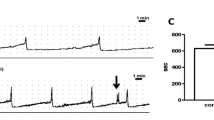Abstract
Purpose
Since it has not been established whether there is an effect on voiding exerted by direct stimulation or blockade of α2-adrenoceptors in the bladder and urethra, MK-467, a peripherally acting α2-adrenoceptor antagonist not penetrating into the CNS, was used to test whether part of the voiding effects of systemically given α2-adrenoceptor agonists is peripheral.
Methods
Urodynamic recordings from 27 conscious male adult C57/Bl J-strain mice were performed. After vehicle (saline) administration, two groups of animals were treated first with the selective α2-adrenoceptor agonist dexmedetomidine (Dex) and then with the selective α2-adrenoceptor antagonists atipamezole (Ati) or MK-467. Two other groups were first treated with Ati or MK-467 and then with Dex.
Results
Treatment with vehicle or α2-adrenoceptor antagonists alone did not affect micturition parameters. All animals treated first with Dex-developed overflow incontinence. Treatment with Ati after Dex reversed almost totally the effects of Dex on all voiding parameters, but treatment with MK-467 after Dex showed no detectable improvement. Treatment with Dex after Ati had no effect on any voiding parameter except maximal pressure. When mice were treated with Dex after MK-467, overflow incontinence was produced in seven of eight animals studied.
Conclusions
The absence of functionally relevant peripheral effects on voiding mediated via α2-adrenoceptors is supported by the finding that neither Ati nor MK-467 alone had any effect on micturition parameters and by the inability of MK-467 to inhibit the effects of Dex, suggesting that the relevant Dex effects were exerted within the CNS.


Similar content being viewed by others
References
Andersson K-E (1993) Pharmacology of lower urinary tract smooth muscle and penile erectile tissue. Pharmacol Rev 45:253–308
Andersson K-E, Wein AJ (2004) Pharmacology of the lower urinary tract: basis for current and future treatments of urinary incontinence. Pharmacol Rev 56(4):581–631
Michel MC, Vrydag W (2006) Alpha1-, alpha2- and beta-adrenoceptors in the urinary bladder, urethra and prostate. Br J Pharmacol 147(Suppl 2):S88–119
Shapiro E, Tsitlik JE, Lepor H (1987) Alpha 2 adrenergic receptors in canine prostate: biochemical and functional correlations. J Urol 137(3):565–570
Levin RM, Ruggieri MR, Wein AJ (1988) Identification of receptor subtypes in the rabbit and human urinary bladder by selective radio-ligand binding. J Urol 139(4):844–848
Andersson KE, Gratzke C (2007) Pharmacology of alpha1-adrenoceptor antagonists in the lower urinary tract and central nervous system. Nat Clin Pract Urol 4(7):368–378
Shapiro E, Lepor H (1986) Alpha 2 adrenergic receptors in hyperplastic human prostate: identification and characterization using [3H] rauwolscine. J Urol 135(5):1038–1042
Taki N, Taniguchi T, Okada K, Moriyama N, Muramatsu I (1999) Evidence for predominant mediation of alpha1-adrenoceptor in the tonus of entire urethra of women. J Urol 162(5):1829–3218
Mattiasson A, Andersson KE, Sjögren C (1985) Adrenergic and non-adrenergic contraction of isolated urethral muscle from rabbit and man. J Urol 133(2):298–303
Nordling J, Meyhoff HH, Christensen NJ (1972) Effects of clonidine (catapresan) on urethral pressure. Invest Urol 16:289–291
Rolfe NG, Kerr CL, McDonell WN (2012) Cardiopulmonary and sedative effects of the peripheral α2-adrenoceptor antagonist MK 0467 administered intravenously or intramuscularly concurrently with medetomidine in dogs. Am J Vet Res 73(5):587–594
Restitutti F, Raekallio M, Vainionpää M, Kuusela E, Vainio O (2012) Plasma glucose, insulin, free fatty acids, lactate and cortisol concentrations in dexmedetomidine-sedated dogs with or without MK-467: a peripheral α-2 adrenoceptor antagonist. Vet J 193(2):481–485
Pandita RK, Fujiwara M, Alm P, Andersson KE (2000) Cystometric evaluation of bladder function in non-anesthetized mice with and without bladder outlet obstruction. J Urol 164:1385–1389
Harada T, Constantinou CE (1993) The effect of alpha; agonists and antagonists on the lower urinary tract of the rat. J Urol 149:159–164
Ishizuka O, Mattiasson A, Andersson KE (1996) Role of spinal and peripheral alpha 2 adrenoceptors in micturition in normal conscious rats. J Urol 156(5):1853–1857
Kontani H, Tsuji T, Kimura S (2000) Effects of adrenergic alpha2-receptor agonists on urinary bladder contraction in conscious rats. Jpn J Pharmacol 84(4):381–390
Jeong MS, Lee JG (2000) The role of spinal and peripheral alpha1- and alpha2-adrenoceptors on bladder activity induced by bladder distension in anaesthetized rat. BJU Int 85(7):925–931
Streng T, Santti R, Andersson KE (2010) Voiding effects mediated by α2-adrenoceptors in the anaesthetized male rat. BJU Int 106(10):1546–1549
Doze V, Chen B-X, Maze M (1989) Dexmedetomidine produces a hypnotic-anesthetic action in rats via activation of central alpha-2 adrenoceptors. Anesthesiology 71:75–79
Conflict of interest
KEA is currently advisor to: Allergan, Astellas and Ferring. The other authors have no conflict of interests.
Ethical standard
The Animal Care Organization and University Ethical Committee of Turku University approved the study protocol. The mice were handled in accordance with the institutional animal care policies of the University of Turku and in accordance with the European Union Directive and with the ethical standards laid down in the 1964 Declaration of Helsinki and its later amendments. All authors have given their informed consent prior to their inclusion in the study.
Author information
Authors and Affiliations
Corresponding author
Rights and permissions
About this article
Cite this article
Aro, E., Bastman, S., Andersson, KE. et al. Is there a peripheral site of action contributing to the voiding effects of α2-adrenoceptor agonists and antagonists?. World J Urol 33, 433–440 (2015). https://doi.org/10.1007/s00345-014-1336-z
Received:
Accepted:
Published:
Issue Date:
DOI: https://doi.org/10.1007/s00345-014-1336-z




